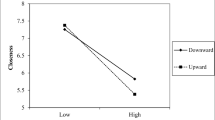Abstract
We tested the relationships between attachment related anxiety and avoidance and interpersonal distance with significant others (mother, father, close friend, love target), as well as, the childhood self. One hundred seventy four university students (85 male and 89 female; average age was 23.90 years, SD = 4.42; 24 [13.8%] were married) participated in the study. They completed Experiences in Close Relationships-Relationship Structures questionnaire (ECR-RS), followed by a computerized version of the comfortable interpersonal distance (CID) task in both the passive state (when protagonists approached them) and the active state (when they approached targets). We asked participants to determine the point at which they felt uncomfortable (the discomfort point) and the point at which they wanted to stop the protagonist (the stop point). Analyses revealed that: (1) Global avoidance scores predicted individuals’ distance to parents, whereas global anxiety scores predicted distance to future love’s view and childhood self; (2) As avoidance increased, individuals allowed their parents to intrude more into their personal spaces; (3) Attachment anxiety and avoidance predicted the passive state better than the active state.


Similar content being viewed by others
References
Ainsworth, M. D. S., Blehar, M. C., Waters, E., & Wall, S. (1978). Patterns of attachment: A psychological study of the strange situation. Hillsdale: Erlbaum.
Bar-Haim, Y., Aviezer, O., Berson, Y., & Sagi, A. (2002). Attachment in infancy and personal space regulation in early adolescence. Attachment & Human Development, 4, 68–83.
Bartholomew, K., & Horowitz, L. (1991). Attachment styles among young adults: A test of a four category model. Journal of Personality and Social Psychology, 61, 226–244.
Becker-Stoll, F., Fremmer-Bombik, E., Wartner, U., Zimmermann, P., & Grossmann, K. E. (2008). Is attachment at ages 1, 6 and 16 related to autonomy and relatedness behavior of adolescents in interaction towards their mothers? International Journal of Behavioral Development, 32(5), 372–380.
Bourne, K., Berry, K., & Jones, L. (2014). The relationships between psychological mindedness, parental bonding and adult attachment. Psychology and Psychotherapy: Theory, Research and Practice, 87, 167–177.
Bowlby, J. (1969). Attachment and loss: Attachment (Vol. 1). New York: Basic Books.
Bretherton, I., & Munholland, K. A. (2008). Internal working models in attachment relationships: Elaborating a central construct in attachment theory. In J. Cassidy & P. R. Shaver (Eds.), Handbook of attachment: Theory, research, and clinical applications (pp. 102–127). New York: Guilford Press.
Burgoon, J. K., & Le Poire, B. A. (1999). Nonverbal cues and interpersonal judgments: Participant and observer perceptions of intimacy, dominance, composure, and formality. Communication Monographs, 66, 105–124.
Cassidy, J., Ziv, Y., Mehta, T. G., & Feeney, B. C. (2003). Feedback seeking in children and adolescents: Associations with self-perceptions, attachment representations, and depression. Child Development, 74, 612–628.
Collins, N. L., & Allard, L. M. (2001). Cognitive representations of attachment: The content and function of working models. In G. J. O. Fletcher & M. Clark (Eds.), Blackwell handbook of social psychology: Interpersonal processes (pp. 60–85). Malden: Blackwell.
Collins, N. L., & Feeney, B. C. (2000). A safe haven: An attachment theory perspective on support seeking and caregiving in intimate relationships. Journal of Personality and Social Psychology, 78, 1053–1073.
DeWolff, M., & van IJzendoorn, M. (1997). Sensitivity and attachment: A meta-analysis on parental antecedents of infant attachment. Child Development, 68, 571–591.
Duke, M. P., & Kiebach, C. (1974). A brief note on the validity of the comfortable interpersonal distance scale. The Journal of Social Psychology, 94, 297–298.
Duke, M.P., Nowicki, S. (1972). A new measure and social-learning model for interpersonal distance. Journal of Experimental Research in Personality, 6, 119–32.
Fineberg, S. K., Leavitt, J., Landry, C. D., Neustadter, E. S., Lesser, R. E., Stahl, D. S., & Corlett, P. R. (2018). Individuals with borderline personality disorder show larger preferred social distance in live dyadic interactions. Psychiatry Research, 260, 384–390.
Fraley, R. C., Niedenthal, P. M., Marks, M. J., Brumbaugh, C. C., & Vicary, A. (2006). Adult attachment and the perception of emotional expressions: Probing the hyperactivating strategies underlying anxious attachment. Journal of Personality, 74, 1163–1190.
Fraley, R. C., Heffernan, M. E., Vicary, A. M., & Brumbaugh, C. C. (2011). The experiences in close relationships-relationship structures questionnaire: A method for assessing attachment orientations across relationships. Psychological Assessment, 23, 615–625.
Fraley, R. C., Roisman, G. I., Booth-LaForce, C., Owen, M. T., & Holland, A. S. (2013). Interpersonal and genetic origins of adult attachment styles: A longitudinal study from infancy to early adulthood. Journal of Personality and Social Psychology, 104(5), 817–838.
Gurevitch, Z. D. (1990). The embrace: On the element of non-distance in human relations. Sociological Quarterly, 31, 187–201.
Hall, E. T. (1963). A system for the notation of proxemic behavior. American Anthropologist, 65, 1003–1026.
Hayduk, L. (1983). Personal space: Where we now stand. Psychological Bulletin, 94(2), 293.
Hazan, C., & Shaver, P. R. (1987). Romantic love conceptualized as an attachment process. Journal of Personality and Social Psychology, 52, 511–524.
Heinonen, K., Raikkonen, K., Keltikangas-Jarvinen, L., & Strandberg, T. (2004). Adult attachment dimensions and recollections of childhood family context: Associations with dispositional optimism and pessimism. European Journal of Personality, 18, 193–207.
Holmberg, D., Lomore, C. D., Takacs, T. A., & Price, E. L. (2011). Adult attachment styles and stressor severity as moderators of the coping sequence. Personal Relationships, 18, 502–517.
Horowitz, M. J., Duff, D. F., & Stratton, L. O. (1964). Body-buffer zone: Exploration of personal space. Archives of General Psychiatry, 11(6), 651–656.
Hudson, S. M., & Ward, T. (1997). Intimacy, loneliness, and attachment style in sexual offenders. Journal of Interpersonal Violence, 12, 323–339.
Kaitz, M., Bar-Haim, Y., Lehrer, M., & Grossman, E. (2004). Adult attachment style and interpersonal distance. Attachment and Human Development, 6, 285–304.
Layden, E. A., Cacioppo, J. T., & Cacioppo, S. (2018). Loneliness predicts a preference for larger interpersonal distance within intimate space. PloS One, 13, e0203491.
Mikulincer, M. (1998). Attachment working models and the sense of trust: An exploration of interaction goals and affect regulation. Journal of Personality and Social Psychology, 74, 1209–1224.
Mikulincer, M., & Shaver, P. R. (2003). The attachment behavioral system in adulthood: Activation, psychodynamics, and interpersonal processes. In M. P. Zanna (Ed.), Advances in experimental social psychology (Vol. 35, pp. 53–152). New York: Academic Press.
Perry, A., Rubinsten, O., Peled, L., & Shamay-Tsoory, S. G. (2013). Don’t stand so close to me: A behavioral and ERP study of preferred interpersonal distance. NeuroImage, 83, 761–769.
Perry, A., Mankuta, D., & Shamay-Tsoory, S. G. (2014). OT promotes closer interpersonal distance among highly empathic individuals. Social Cognitive and Affective Neuroscience, 10, 3–9.
Perry, A., Nichiporuk, N., & Knight, R. T. (2016). Where does one stand: A biological account of preferred interpersonal distance. Social Cognitive and Affective Neuroscience, 11(2), 317–326.
Pistole, M. C. (1994). Adult attachment styles: Some thoughts on closeness distance struggle. Family Process, 33, 147–159.
Ponizovsky, A. M., Finkelstein, I., Poliakova, I., Mostovoy, D., Goldberger, N., & Rosca, P. (2013). Interpersonal distances, coping strategies and psychopathology in patients with depression and schizophrenia. World Journal of Psychiatry, 3(3), 74–84.
Rowe, A. C., & Carnelley, K. B. (2005). Preliminary support for the use of a hierarchical mapping technique to examine attachment networks. Personal Relationships, 12, 499–519.
Scharf, M., Oshri, A., Eshkol, V., & Pilowsky, T. (2014). Adolescents’ ADHD symptoms and adjustment: The role of attachment and rejection sensitivity. American Journal of Orthopsychiatry, 84, 209–217.
Shamasundar, C. (1999). Understanding empathy and related phenomena. American Journal of Psychotherapy, 53, 232–245.
Spielmann, S. S., MacDonald, G., Maxwell, J. A., Joel, S., Peragine, D., Muise, A., & Impett, E. A. (2013). Settling for less out of fear of being single. Journal of Personality and Social Psychology, 105, 1049–1073.
Uzzell, D., & Horne, N. (2006). The influence of biological sex, sexuality and gender role on interpersonal distance. British Journal of Social Psychology, 45, 579–597.
Veitch, R., Getsinger, A., & Arkkelin, D. (1976). A note on the reliability and validity of the comfortable interpersonal distance scale. The Journal of Psychology, 94(2), 163–165.
Westmaas, J., & Silver, R. C. (2001). The role of attachment in responses to victims of life crises. Journal of Personality and Social Psychology, 80, 425–438.
Yukawa, S., Tokuda, H., & Sato, J. (2007). Attachment style, self-concealment, and interpersonal distance among Japanese undergraduates. Perceptual and Motor Skills, 1255–1261, 10 104.
Availability of Data and Material
Not applicable.
Code Availability
Not applicable.
Author information
Authors and Affiliations
Corresponding author
Ethics declarations
Conflicts of Interest/Competing Interests
The authors declared no conflicts of interest with respect to the research, authorship, and/or publication of this article.
Additional information
Publisher’s note
Springer Nature remains neutral with regard to jurisdictional claims in published maps and institutional affiliations.
Rights and permissions
About this article
Cite this article
Akbarian, H., Mazaheri, M.A., Zabihzadeh, A. et al. Attachment-related anxiety and avoidance and regulation of interpersonal distance in close relationships. Curr Psychol 41, 4638–4644 (2022). https://doi.org/10.1007/s12144-020-00939-2
Published:
Issue Date:
DOI: https://doi.org/10.1007/s12144-020-00939-2




